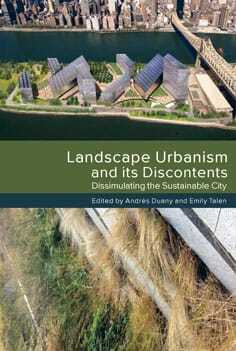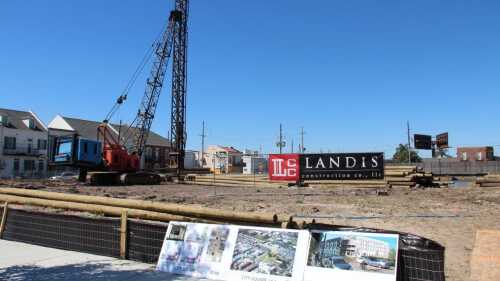Andrés Duany and Emily Talen, editors
New Society Publishers
P.O. Box 189, Gabriola Island, BC, Canada VOR 1XO; www.newsociety.com.
2013. 316 pages. Paperback, $29.95.
This lively book describes a design war raging between the supporters of the new urbanism and backers of landscape urbanism. Whereas most people likely have been unaware of this conflict, intellectual warriors have been battling in design schools and studios over which approach will dominate the field of urban design. To these combatants, the stakes are high: which vision will shape the future of urbanism and decide the question of the human presence in nature.
The tenets of new urbanism have become widely accepted as the gold standard of urban design by city planners and real estate developers since the Congress for the New Urbanism issued its charter in 1999. Seeking to supplant suburban sprawl with traditional urban form and walkable neighborhoods, this movement issued codes based on the rural-to-urban transect—a model that defines a series of zones characterized by a dominant type of development, from sparse rural areas to high-density urban cores—and provided standards for certification under the LEED for New Development program. Urban planners and developers enthusiastically reformed their regulations and project plans to generate mixed uses, higher densities, and public spaces and street corridors defined by building frontages—essentially a disciplined architectural vision of the city.
In recent years, a quiet revolution has been incited by a cadre of landscape architects fighting under the banner of landscape urbanism. Led by academic polemicists such as Charles Waldheim of Harvard University and James Corner of the University of Pennsylvania, this movement rejects new urbanism’s grids, blocks, and disciplined public spaces in favor of landscape as the structuring medium of the urban fabric. It co-opts architects, offering them carte blanche to build their most extreme structures within free-flowing sweeps of natural or symbolic landscapes. No longer constrained by urban codes and standards, eye-catching designs appear in the folded planes and metal skins of scores of new museums and public buildings set in leafy, green surrounds.
Backers of this approach label new urbanism a stodgy and old-hat attempt to restore an outdated version of urbanism while holding back the creativity of contemporary designers through overly restrictive regulatory regimes and master plans. Landscape urbanism lauds the indeterminacy and flux of nature, allowing freely designed buildings to stand within buffering landscapes. Its advocates accept the status quo of low-density urbanism as something that cannot be changed. They oppose all metrics of performance except for those of hydrology, even if it means deconstructing existing urban fabric and social diversity. They love the high-design look of randomness, even if it is carefully constructed and disguised by green roofs and walls.
The editors of Landscape Urbanism and its Discontents are leading advocates and defenders of new urbanism. Andrés Duany heads the architecture firm of Duany Plater-Zyberk & Co. A cofounder of the Congress for the New Urbanism, Duany burst to fame as the designer of the new town of Seaside, Florida. Emily Talen is a professor of geographical sciences and urban planning at Arizona State University. Both have published extensively on the concepts and applications of new urban design and planning.
Duany and Talen have assembled an array of fellow authors to critique landscape urbanism. The 18 chapters in this collection range from carefully balanced analyses of the underlying theory by Talen to free-swinging attacks by James Howard Kunstler on landscape urbanism’s slippery language and overblown claims. Some authors call for the two approaches to join forces in a negotiated peace, integrating each other’s strengths in a more effective urbanism that can cope with coming challenges of climate change and other phenomena.
Doug Kelbaugh, professor of planning and architecture at the University of Michigan, offers a balanced analysis. He points out the advantages of cities over sprawl in terms of sustainability. City impacts are lower per capita (though higher per acre) in terms of greenhouse gas emissions and air and water pollution. Cities deliver higher personal and collective productivity and are more efficient in terms of land consumption, infrastructure, transportation, and communication. In his view, however, neither movement is yet up to the task of creating sustainable cities. He calls for cross-fertilization of the movements, concluding that there is not enough urbanism in landscape urbanism and not enough ecology in new urbanism.
New York City’s High Line has emerged as a prime battleground for the two sides. Designed by James Corner, this urban promenade is ballyhooed as a prime example of landscape urbanism’s opportunistic creativity. Immensely popular, this 1.45-mile-long (2.3 km), 2.9-acre (1.2 ha) elevated urban park has spurred massive redevelopment of the formerly derelict Meatpacking District on the city’s lower west side. Rescued from demolition by the nonprofit Friends of the High Line, this elevated freight-rail line operated between 1934 and 1980 to transport produce from the Meatpacking District without disturbing street-level traffic. Once abandoned, it was taken over by colonizing vegetation. Adjacent property owners saw it as blight and demanded its removal. Salvaging it required support from New York City Mayor Michael Bloomberg and the city’s planners, who created a system of transfer-of-development rights that mollified opponents.
Critics of landscape urbanism point out the High Line’s flaws. Even at a cost of $30,000 per linear foot for its first two sections, it falls short of achieving landscape urbanism’s rhetoric of social justice or ecological balance, they say. Not only does its high design require levels of maintenance and security staff far beyond those of other local parks, but also the Friends of the High Line keep the money from its concessions. With more than 30 new hotel and apartment projects underway or completed, it is a gentrification engine par excellence, but the distribution of benefits is not equitable: some neighborhood businesses have closed due to loss of customers or increased rent.
So the battle to design the urban soul goes on. Some see hope in ecological urbanism, an approach that brings together the strengths of the two contending movements. Meanwhile, neither side has shown signs of standing down.
David R. Godschalk is professor emeritus at the University of North Carolina at Chapel Hill and coauthor of Sustainable Development Projects: Integrating Design, Development, and Regulation, published by APA Planners Press in 2013.





